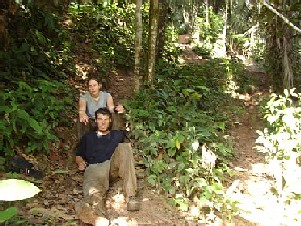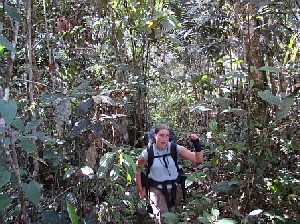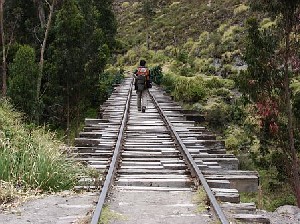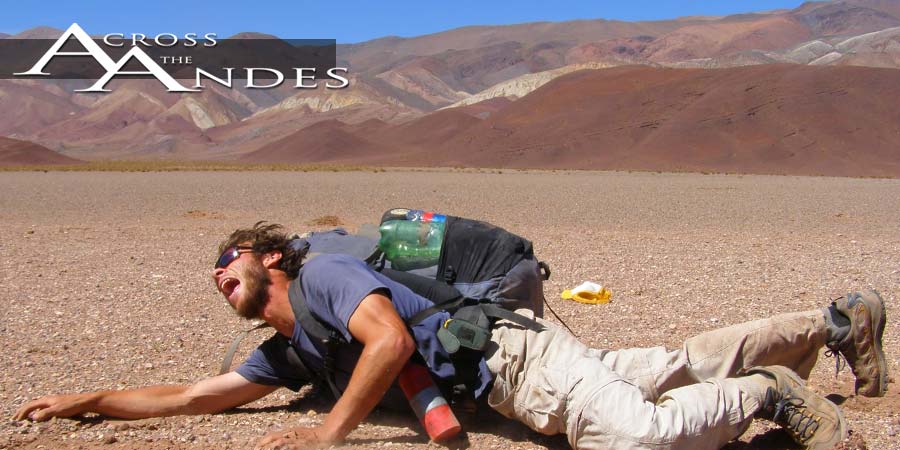Jungle Calls
By Gregg Treinish
August 6, 2006

After being in the mountains for quite awhile, we decided
that we wanted to experience more of Ecuador. The Amazon was calling us
and who are we to deny such calling? We knew little about travel in the
jungle and little about what we would see and experience there. Our
plan was to go as far into the basin as we could get, and offer to work
in exchange for information about living in the jungle. Traveling by
bus (don´t worry, only to the East, not South) to Arajuno, we watched
as the vegetation began to change. Dropping nearly 13,000 ft. we saw
ferns become larger than either of us and at times larger than the bus
we were riding in. The feeling of going into the Amazon is one that is
pretty different than either of us have experienced before. All of the
movies, the books, the stories about an area of the globe that is
mostly unexplored and almost totally untouched make the experience
exciting to say the least. Situated just on the inside edge of the
fuzzy line that separates Selva (Jungle) from just thick thick forest,
Arajuno happened to be wrapping up the third day of their annual
foundation fiesta . At first, pulling up in the bus, our immediate
reaction to this was, "How lucky!" When we got off the bus and realized
just how wasted everyone was, that this was our first time around
people of the jungle, and that we were attracting crowds of more and
more people insistent on us drinking with them, we grew slightly
concerned. More than a bit sketched out we made our way to the house of
the president of the foundation of the city; he was sober. It was here
that we would be introduced to our first jungle guide, Walter Canelos.
Walter is a twenty-seven year old who as his last name suggests lives in the Pueblo of Canelos, which happened to be the next stop on our very loose itinerary. Unhappy that he wouldn't be getting paid for his services, Walter took us anyway into the thick of it with nothing more than a tiny red shoulder pack and some Keds. Almost immediately we were more than happy to have a guide with us. Trails diverge in the jungle in just about every direction and there is absolutely no indication of which goes where or if they are even trails used by humans as apposed to just the animals. In addition, it was hot, really hot and with mud up to our knees at points, rivers to ford, insects that conveniently missed our guide but managed to swarm and sting the two of us, and absolutely no place to pitch a tent that was free of mud, rocks, or vegetation so thick that it could support you walking on it except in that one spot where you fall through a good five or six feet, the jungle was proving to be a formidable place. Yes the jungle was a whole new world and even lugging our 40lb. packs didn't leave us prepared at all! We spent two days, partially bushwhacking and partially following trails that were overgrown and hard to follow. During these two days, it was wet, not from the rain but from the heavy sweat that both of us had going. You may as well have dunked us into a pool as we were both completely drenched from head to toe. Walter, who hadn't even broken a sweat was insistent that we keep moving and at a nearly sprinting pace. Our legs began to cramp as dehydration set in and despite the more than amazing scenery, we both agreed that our pace was much too fast to enjoy the beauty that sat on every leaf, every tree, and in every Tarzan-like vine. When we did get a short opportunity to look around, what was there was more than astounding. Aside from the bug that ate a whole almond I put next to it to get perspective for a photo, there were stick bugs that unless you were specifically looking for them, they would simply blend into the background, there were more butterflies than either of us have ever seen in all different colors, red, blue, green, yellow, purple---it didn't matter what it was really, everything exists not only in one or two colors, but five or six. Birds, again of every color, sing throughout the day and night and the quick glimpses that we did manage of them reminded us that we were in a very special place. We saw some toucans as well though they were a bit far away for a good look. The sounds of the jungle are perhaps the most spectacular part. Never for one second did we hear silence. More than a couple of times we were sure that the aliens from ET had landed near by. The songs that go back and forth both between the insects and the birds make you very aware that you are surrounded by life, even if it has evolved to blend in and make itself very hard to see. Every second it seemed like we were hearing a new song, a new chirp, or a new buzz that each made Deia and I laugh at its peculiarity.

Two days after setting out we limped into Canelos soggy, and badly bitten. Walter's wife made us some comidas typicas or typical foods of the jungle and we gladly accepted an invitation to relax until morning. We bathed in the river and had a unique opportunity to experience life as it was thousands of years ago. With stone tablet floors and thatch roofs, the Canelos home is far different than what we were used to. There are no walls to separate outside from in and it really felt as if we had walked into paradise. It is really quite amazing what you can find with a machete in the jungle. Everything is used for something, and whatever you need, can be found. We were fed sugar cane, plantains, yuca root, fish from the rivers, and fruits that I can barley describe, let alone name. We watched as Walter's mom and his wife made dinner over an open fire that sat on the floor. Everyone was barefooted and the utensils used for cooking looked as if they had been lifted from Mesa Verde. After watching one of the more spectacular rain storms I have seen, we reluctantly left Walter and his family the next day knowing that we needed to keep moving south.
Setting out with intentions of reaching the jungle town
of Macas in four or five days, we decided on a bit easier route for
this stretch. Everything was going well in our progression south when
we came across Segundo and Rosa walking along with a Machete and a bag
of some type of food gathered near their home. We accepted an
invitation to their home and wound up at "Everybody's Jungle" an
incredibly beautiful jungle getaway for tourists. Almost immediately we
fell in love with the place and were unable to drag ourselves away to
keep hiking. We enjoyed a tilapia dinner and split a bottle of whiskey
with Guido, the owner. We spent the night above the river in a thatch
hut and marveled at the foot and a half long grasshopper-like insects.
We dragged ourselves away the next day with strong feelings that
someday we would return.
We continued south with another small stint in the thick
of it. We saw our first monkeys though they were pets of the locals and
eventually made our way to Communa Santa Ana. When we began this trip,
both of us had stated that learning sustainability and experiencing
fully the way of life in South America were goals of ours. For this
reason, we knew that in a community that already had five or six
volunteers working on a project to provide clean water, we had to stay
and learn. Still right on the fringes of the jungle we were not sure
what to expect, but Rebecca, the 78 year old founder of the community
lead us to la casa de Wilo. He would be our host for the next three
days. Wilo is a carpenter and our work in exchange for food would be
carrying trees up from near the Rio Pastaza to his and Rebecca's
houses. The houses here were set up much like those in Canelos, and
that is where the similarities ended. It was disappointing to see that
a community in a place so rich with natural resources has become so
dependant on town and even more unfortunately on the volunteers that
live and pay to live there. Rebecca, too, expressed that she is unhappy
with how the town has lost touch with its surroundings and that the
vision she had in creating it, is all but lost. Santa Ana is not a town
in need. The people who are living there spend their days making
crafts, eating, and for the most part, healthy. Granted we only spent a
few days there, but it was clear that the aide this town is receiving
is probably hurting more than helping. In addition to becoming
dependant on the $120 per month that the volunteers each pay, a new
water system will surely leave future generations without the
antibodies to keep them healthy after drinking river/rain water. In
Canelos, time was spent relaxing and enjoying surroundings, in Santa
Ana, it seemed everyone was busy with chores to help pay for
electricity and the new water system. The local Shaman required a fee
to even go and look at Deia who was running an extremely high fever and
had severe stomach problems as well. I was offered Floripauna, a
hallucinogenic that comes from the bark of the Floripauna tree and
locals say will make you see your future. It has been a desire of mine
to explore this part of the culture, while being guided by a Shaman. I
was handed the drug in a plastic cup and told that I would take it in
Wilo's house---not what I had in mind. I respectfully declined and must
say that I was disappointed with the causality of something I know has
long been part of the culture. I believe that this is another symptom
of a town that has lost touch with its roots. I will say that the
hospitality of Wilo and Rebecca was truly amazing and they really made
every effort to make us feel at home. We left saddened to see that the
ways of the outside world had spread a little further in last few years
into the Selva.
At this point, with Deia extremely sick most likely after drinking some bad water, and both of us bitten, wet, and hot, we decided to return home to the mountains. Almost immediately our trip home was rewarded with spectacular views of Chimborazo, the largest volcano in Ecuador. With at least three choices of route, we walked along a ridge top for the last two days meeting what seemed like hundreds of people. We were told that we are the first Americans that have visited this remote part of the Quechuan Andes and almost everyone has stopped us to ask about our trip, most of them thinking we must be lost or in some sort of trouble. All of them are truly amazed to learn that we have walked from near Quito and that we want to walk to Peru, we rarely bother explaining that we are hiking all the way to Tierra del Fuego. We have currently reached the town of Guamote which is halfway between Riobamba and Alausí. We are currently walking along the famous El Náriz del Diablo train line, and should reach Cuenca within a week. To date, we have hiked around 350km and have hiked just over halfway through Ecuador. We are both hiking strong, though Deia is still sick with stomach issues. Please keep the emails and comments coming, it is good to hear from all of you.








